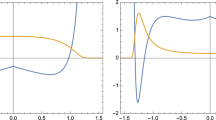Summary
The quantum-mechanical problem of the nonlinear oscillator with the Lagrangian L= 1/2 [x 2-k0x 2)/(l-λx2 )] is solved exactly and the energy levels and eigenfunctions are obtained completely. This model (whenk 0=0) is the zero-space-dimensional isoscalar analogue of the nonlinearSU 2⊗ SU2 chirally invariant Lagrangian in the Gasiorowicz-Geffen co-ordinates and may also be considered as a modified version of the anharmonic-oscillator and Lee-Zumino models. The bound-state energy levels are found to have a linear dependence on the coupling parameter, in sharp contrast to the case of the familiar oscillator With quartic anharmonicity where the energy, as a function of λ, has complicated singularities at λ = 0. We investigate how far certain standard approximation procedures reproduce the exact results. The Bohr-Sommerfeld quantization procedure is found to reproduce the form of the boundstate energy levels correctly. Interestingly a perturbation-theoretic treatment also reproduces the correct results at least up to the order (λ2) to which we have carried our calculations.
Riassunto
Si risolve esattamente il problema della meccanica quantistica dell’osoillatore non lineare con lagrangianoL = 1/2 [(x 2-k0x2)/(l-λx2)] e se ne ottengono completamente le autofunzioni e i livelli energetici. Questo modello (quandok 0 = 0) è l’analogo isoscalare con dimensione spaziale nulla del lagrangiano chiralmente invarianteSU 2 ⊗ SU2 non lineare nelle coordinate di Gasiorowicz-Greffen e si può anche considerare come una versione modificata dei modelli dell’oscillatore anarmonico e di Lee-Zumino. Si trova che i livelli energetici di stato legato dipendono linearmente dal parametro di accoppiamento, in evidente contrasto con il caso familiare di oscillatore con anarmonicità del quart’ordine in cui l’energia, espressa in funzione di λ, presenta complicate singolarità per λ = 0. Si cerca di vedere sino a che punto certi procedimenti standard di approssimazione riproducono i risultati esatti. Si trova che il metodo di quantizzazione di Bohr-Sommerfeld riproduce correttamente la forma dei livelli di energia degli stati legati. È interessante che anche un trattamento con la teoria delle perturbazioni riproduca correttamente i risultati almeno fino all’ordine (λ 2) al quale si sono spinti i calcoli.
Резюме
Точно решается квант овомеханическая проблема нелинейног о осциллятора с Лагранжианом \(L = \frac{1}{2}\left[ {(x^2 - k_0 x^2 )/\left( {1 - \lambda x^2 } \right)} \right]\). Полу чены уровни энергии и собственные функции. Эта модель (когда k0=0) представляет изоска лярный аналог с нулевой пространст венной размерностью для нелинейногоSU 2⊗SU 2, ки рально инвариантного Лагра нжиана в координатах Газиоровича-Геффена и может рассматриват ься как модифицированны й вариант ангармонич еского осциллятора и моделей Ли-Зумино. Обн аружено, что энергети ческие уровни связанных сос тояний имеют линейную завис имость от параметра с вязи в противоположность с лучаю обычного осциллятор а с квадратичной ангармоничностью, дл я которого энергия, как функция Л, имеет си нгулярность при λ=0. Мы исследуем, насколько процедуры стандартных приближ ений воспроизводят т очные результаты. Получено, что процедура квантования Бора-Зом мерфельда правильно воспроизводит форму энергетических уровней свазанных со стояний. Интересно от метить, что в теории возмущений также получаются пра вильные результаты, п о крайней мере, до порядка (λ2), в ко тором мы производили наши в ычисления.
Similar content being viewed by others
References
S. Gasiorowicz andD. Geffen:Rev. Mod. Phys.,41, 531 (1969).
E. Delbourgo, A. Salam andJ. Steathdee:Phys. Rev.,187, 1999 (1970).
A. P. Hunt, K. Köller andQ. Shaffi:Phys. Rev. D,3, 1327 (1971).
K. Nishijima andT. Watanabe:Prog. Theor. Phys.,47, 996 (1972);B. Sugano:Prog. Theor. Phys.,49, 1352 (1973).
I. S. Gerstein, R. Jackiw, B. W. Lee andS. Weinbeeg:Phys. Rev. D,3, 2486 (1971).
J. Chaeap:Journ. Phys.,6 A, 393 (1973).
G. V. Effimov:Nucl. Phys.,74, 657 (1965);E. S. Feadkin:Nucl. Phys.,49, 624(1963);M. K. Volkov:Ann. of Phys.,49, 202(1968);B. W. Keck andJ. G. Tayloe:Phys. Rev. D,3, 1846 (1971).
T. D. Lee andC. N. Yang:Phys. Rev.,128, 885 (1962).
S. Fels:Phys. Rev. D,1, 2370 (1970).
A. Jaffe:Comm. Math. Phys.,1, 127 (1965);Rev. Mod. Phys.,41, 576 (1969).
P. M. Mathews andM. Lakshmanan:Ann. of Phys.,79, 171 (1973).
C. M. Bender andT. T. Wu:Phys. Rev. D,7, 1620 (1973);184, 1231 (1969).
P. M. Mathews andM. Lakshmanan:Quart. Appl. Math.,32, 215 (1974).
K. Meetz:Journ. Math. Phys.,10, 587 (1969).
B. W. Lee andB. Zumino:Nucl. Phys.,13 B, 671 (1969).
M. Lakshmanan:Journ. Phys.,7 A, 889 (1974).
B. Simon:Ann. of Phys.,58, 77 (1970).
H. E. Lin, W. C. Lin andR. Sugano:Nucl. Phys.,16 B, 416 (1970).
Batesman Manuscript Project, Higher Transcendental Functions, Vol.1, edited byA. Erdelyi, W. Magnus, F. Oberhettinger andF. Gr. Tricomi (New York, N. Y. 1953), p. 122. Hereafter this is referred to as BMP.
H. Joos:Fortschr. Phys.,10, 65 (1965).
I. S. Gradshteyn andI. S. Ryszik:Tables of Integrals, Series and Products (New York, N. Y., 1965).
I. I. Goldman andV. D. Krivchenkov :Problems in Quantum Mechanics (London, 1961), p. 55.
S. Flügge:Practical Quantum Mechanivs (Berlin, 1971), p. 94.
P. M. Morse andS. Feshbach: Methodsof Theoretical Physics, Vol.1 (New York, N. Y., 1953), p. 768.
M. Rasetti:Int. Journ. Theor. Phys.,5, 377 (1972).
Author information
Authors and Affiliations
Rights and permissions
About this article
Cite this article
Mathews, P.M., Lakshmanan, M. A quantum-mechanically solvable nonpolynomial Lagrangian with velocity-dependent interaction. Nuov Cim A 26, 299–316 (1975). https://doi.org/10.1007/BF02769015
Received:
Published:
Issue Date:
DOI: https://doi.org/10.1007/BF02769015



